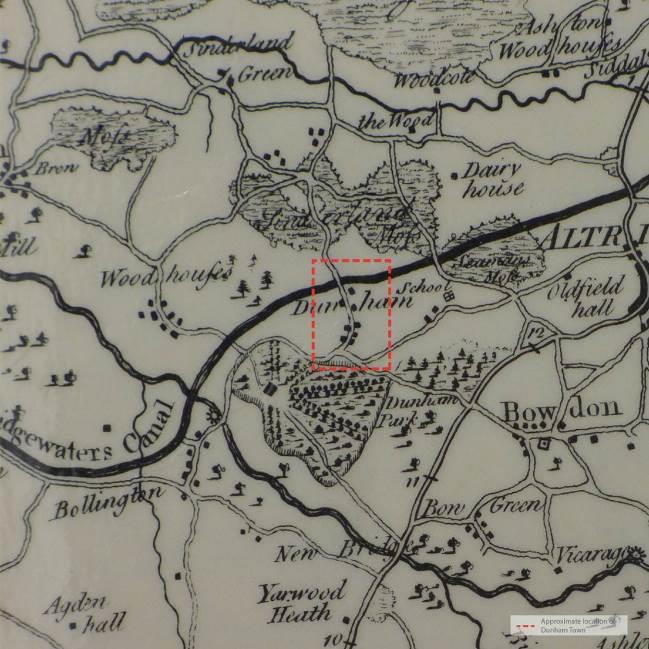History of Dunham Town
Historic development of Dunham Town
Formerly sited in the parish of Bowdon, and located just to the north of the great house of Dunham Massey, the historic development of Dunham Town is intimately connected with the Dunham Massey estate.
The village of Donehame is mentioned in the Domesday Book, which suggests that the settlement was established by the 11th century. The village of Dunham Town and the Manor of Dunham Massey were transferred to Hamo de Massey in the same period, remaining in the hands of the de Massey family until the mid-14th century.
After the last Hamo de Massey died in the 1340s without an heir, the manor passed to the Ingham family, and then successively to the Stranges, Fittons and Venables. In the mid-15th century the hamlet of Dunham Town and the associated manor house passed to the Booth family, who then held the seat until the mid-18th century. The earliest structures surviving in Dunham Town today appear to date from the 17th century but with some rare instances of surviving earlier fabric:
- Yew Tree Cottage and Lime Tree Cottage are noted as potentially containing 16th- or 17th-century fabric;
- Magnolia Cottage may potentially contain 16th-century fabric; and
- There is evidence in the built structures at Little Heath Farm that they contain older recycled timbers.
Dunham Town in this period was still owned by the Booth family, who were highly influential in local and national political spheres. Sir George Booth was one of the most notable politicians of the early Stuart court, while his son William Booth and grandson, also George Booth, maintained the family’s important national position. Sir George led the Royalist Booth Uprising in Lancashire, Cheshire and North Wales in 1658 in opposition to the Rump Parliament. This represented the most successful attempt against this parliament in the period, although it was ultimately unsuccessful.
In the 18th century the 2nd Earl of Warrington, another George Booth, rebuilt the house at Dunham Massey and also remodelled the landscape. There are, concurrently, several houses in Dunham Town which also appear to date to this period although none appear to directly relate to the second Earl. These include the three Big Tree Cottages on Woodhouse Lane, the early 18th-century Ivy House, and the mid-18th-century Big Tree House.
The latter part of the 18th century also brought some development of the town: Dunham School was built by Thomas Walton in 1759, while a public road bridge was constructed in the 1770s at the same time as the cutting of the Bridgewater Canal through the settlement. New farmhouses and cottages also appear to date from this period, for example Rose Cottage, Farm Cottage and Dog Farmhouse. All three are located on Woodhouse Lane, which formed the historic core of the settlement.

Map 1: Burdett 1777
Despite the significant additions and changes in the 18th century, it is evident from the 1842 tithe map that the settlement of Dunham Town was still very much a hamlet in the 19th century, by which stage it had passed to the Grey family via the marriage of Mary Booth, the last George Booth’s only daughter and heir. Prolific among the buildings in Dunham Town are modest 18th- and early 19th-century red brick workers’ cottages built as accommodation for those employed at the Dunham Massey estate. An early 20th-century photograph of Rose Cottage on School Lane indicates that these cottages were at some point whitewashed, and had the distinctive split-timber picket fence which has been recently been reinstated at several properties throughout the Conservation Area.
Another row of cottages also called Big Tree Cottages date from the early 19th century: a watershed in the history of Dunham Town and it is apparent that much of the rest of Dunham Town was developed in the later 19th and early 20th centuries. From archival sources, it is evident that the land was sold to a local speculative builder Mark Clarke by the Trustees of the Earl of Stamford and Warrington, signed notably by his widow Catherine, Countess of Stamford and Warrington. ‘Big Tree’ refers to the large tree at the Woodhouse Lane/Charcoal Road junction.
It is perhaps no coincidence that several parcels of land were sold for development during the latter half of the 19th century, under the Countess’ watchful eye. The Earl’s second wife, Catherine (née Cocks) was a circus performer whose marriage to the Earl was widely disapproved of by the local community. The scale of local disapproval quickly led the couple to remove to their estate at Enville in Staffordshire for the rest of their lives, leaving the great house at Dunham empty.
It therefore seems likely that the sale of land in Dunham Town may have held particular personal significance for the Countess. Regardless of this personal story, Mark Clarke’s development of Dunham Town brought a degree of speculative development to the area. This echoed, to a much smaller degree, the transformation of the wider Trafford area into 16 residential suburbs to serve industrial Manchester, made possible by the construction and expansion of the railways from the 1840s onward.
It is notable that, despite the small incursion of speculative development during this earlier period, Dunham Town remains largely untouched by the suburbanisation of the Greater Manchester area and the settlement retains its historic street and plot patterns. Later 20th-century developments, including the construction of a bypass to the village in the mid-1980s and the rebuilding of an historic wall along the line of the new road between Charcoal Lane and Woodhouse Lane, have also had little overall impact on the footprint of the historical settlement of Dunham Town.